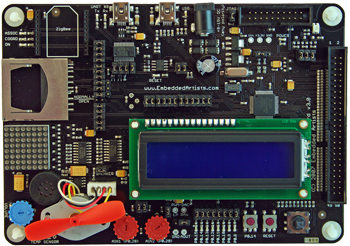
Equipped with LPC2148. 32k RAM, 512k ROM, 2*UART, 2*I2C, SPI, 2x8/10b AD converters, PWM, USB 2.0 USB (client), UART/RS232, PWM (motor), 2x16 character LCD, AD/DA, diodes, 5-key joystick.
Additionally Ethernet and ZigBee interfaces.
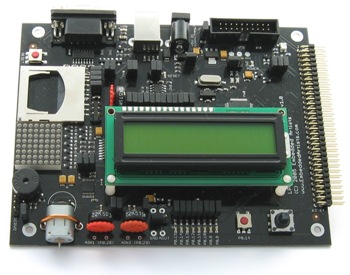
Additionally expansion board.

| Documentation |
|---|
| User's
guide v1.0 User's guide v3.0 |
| QuickStart Program Development User's Guide |
| Schematics
v1.0 Schematics v3.0 |
| Software for applications incorporating USB |
| Beyond Logic's homepage |
| http://www.micrium.com/philips/ (the Author of uCos-II RTOS, example programs) |
| Virtual COM on USB |
| www.keil.com/download/docs/306.asp www.keil.com/download/docs/307.asp www.keil.com/download/docs/308.asp |
| sourceforge.net/projects/lpcusb |
| Mouse HID |
| USB stack Sourceforge |
| Preinstalled program |
| Hex
v1.0
Terminal parameters: 38400 bps (8N1) Hex v3.0 Terminal parameters: 38400 bps (8N1) |
| Sources |
| ver
1 (GNU 3.4, USB module will not compile with ver. 4) ver 1 for GNU 4 with file system (just unpack to /eclipse/Demo/2138/) ver 2 (GNU 4, motors need to be turned off to avoid system halt) ver 3 NAS Server Communicating with ZigBee module over UART#1 (demo) |

| Documentation | |
|---|---|
| Schematics | |
| Example applications | |
| Example driver with ICMP Echo (PING) functionality. SPI #0 channel is used to communicate with ENC28J60 | ethDrv.zip |
| Web server (tcp/http) based on uIP library. SPI #0 channel is used to communicate with ENC28J60 | ethDrv.zip |

| Documentation | |
|---|---|
| Schematics |
LPC 2104; 16k RAM, 128k ROM, 2*UART, I2C, SPI, PWM, interfaces UART and Bluetooth (only SPP), color LCD 200x2000, 5-key joystick.

| Documentation | |
|---|---|
| User's guide | |
| QuickStart Program Development User's Guide | |
| Schematics
- version without JTAG Schematics - version with JTAG |
|
| Software | |
| Demo program | Source
code Binary image (hex file) |
| Program
for image conversion
(written in Java). Converts jpg, png, gif, and bmp images into C-language type array so that they can be displayed on the LCD matrix. |
img_conv.jar Usage: java -jar img_conv.jar nameOfPicture
[options] |
| Chess (Rob Jansen) | game_chess_1.8.zip |
| 15 (Sulaiman Vali) | game_fifteen_1.9.zip |
| Sudoku (Anders Lindvall) | sudoku_1.9.zip |
| Poker (Jere Knaappila) | game_poker.tar.gz just the hex-file |
| TicTacToe [pol. kółko i krzyżyk] (Will Jenkins) | TicTacToe_v1.0.tar.bz2 |
| Connect 4 (Will Jenkins) | Connect4_v1.0.tar.gz |
| Rotator (Sulaiman Vali) | Rotator_v1_0.zip just the hex-file |
| Cards
(Michael Kraus) Short description: •2 Players play against each other: player1 (P1, red color) and player2 (P2, blue color) •each player has 11 cards with values from 1 to 11 •each player places one of his cards hidden •the placed cards are opened and the player with the higher card value gets a point •if the 2 cards have the same value, nobody gets a point •You can select between 2 modes at the start of the game: - one player mode: the role of player2 is taken by the ARM uC by placing a random card - two players mode: two real players can play against each other |
cards.zip |
| Memory (Otto Effinger) Short description: •2 Players play against each other: player1 (P1, red color) and player2 (P2, blue color) •there are 21 pairs of cards (same image), randomly placed on the field •all cards are hidden (grey fields), each player has to find card pairs •player has to open 2 cards: select with up/down/left/right keys, then press Center key •if the 2 cards match, player gets a score point and may continue to play •if the 2 cards do not match, they are hidden again and the next player continues •after each 2 cards, one of the up/down/left/right keys has to be pressed to continue •status line: left: score of player1 •status line: left: middle: shows, which player has to open cards •status line: left: right: score of player2 |
memory.zip |
| Labirynth with various
enhancements (Audrius Urmanavicius) Short description: •A Maze game; the objective of the game is to find a path to an exit location (from upper left to bottom right corner). •There is no 'shortest' path - there's always one and only one path between any two points in a maze (including start and finish points). •Program demonstrates menu callbacks to set game field size. •To make more fun, it is possible to hide walls until they are bounced at. The aim is to find a path to an exit making least possible moves and hitting least possible walls. Longer description of general improvements: http://fox.mediaworks.lt/~audrius/embedded/ |
LPC2104-Audrius.zip just the hex-file |
| Sokoban
(Michael Gaus) Short description: •Sokoban (Japanese for "warehouse keeper") is a transport puzzle in which the player pushes boxes around a maze, viewed from above, and tries to put them in designated locations (target fields). Only one box may be pushed at a time, not two, and boxes cannot be pulled. •the game has 20 levels (00-19) at the moment, additional levels can be added in sokoban_levels.h •each level has 12 fields horizontally (XSIZE) and 11 fields vertically (YSIZE) •by pressing the Center key during a game, the game can be paused and you have various options to continue: continue current level, restart current level, select another level (use right/left key to select level), terminate game •status line: shows level (Lxx), playing time in minutes:seconds (Txx:xx), number of moves (Mxxx) •the fields are shown as follows: •- border field: grey •- free field: yellow •- box: brown with a frame around a cross •- empty target field: red with a dashed frame around a cross •- box in a target field: red with a continuous frame around a cross •- player: the smart blue guy ;-) (yellow background if player is on a free field, red background if player is in a target field) |
sokoban.zip just the hex-file |
| Breakout (Tomas Soderqvist) | breakout.rar just the hex-file |
| Styx
(Tomas Holmqvist) Short description: •The goal is to "take" as large part of the screen as possible. •Taken parts of the screen are colored by a picture. •If you move into your own tail or the styx touch it, the game is over. •Pointers to the pictures are in the variable: levelmap[] Some parts left to be done: •Show where the marker is, even when it is at the edges. •Fix strat-bug. Sometimes the styx does not show. •Fix bug that the styx can sometimes pass the edges. |
styx-1.0.tar.gz just the hex-file |
| Graphical
Demo (Peter Moraliyski) This program demonstrates the capabilities of the LCD. |
toasterdemo.zip just the hex-file |
16k RAM, 128k ROM, 2*UART, I2C, SPI, AD/DA. Possibility of connecting expansion board.
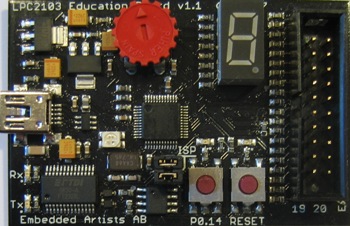
| Documentation | |
|---|---|
| User's guide | |
| QuickStart Program Development User's Guide | |
| Schematics | |
| Documentation | |
| Demo
application Hex. Terminal parameters: 115200 bps (8N1) |
|
| Basic verification test |
32k RAM, 512k ROM, 2*UART, 2*I2C, SPI, 2x8/10b AD converters, PWM, sensors, bread board. Possibility of connecting ZigBee and expansion board.

| Documentation | |
|---|---|
| User's guide | |
| QuickStart Program Development User's Guide | |
| Schematics | |
| Software | |
| Demo application - hex. Terminal parameters: 115200 bps (8N1) | |
| Basic verification test | |
| Source code of programs for bread board | |
| Demo for communicating with ZigBee over UART#1 |
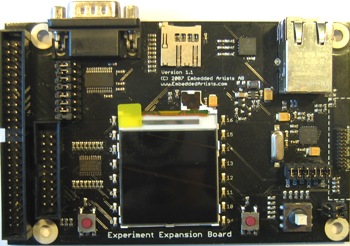
| Documentation | |
|---|---|
| User's guide | |
| QuickStart Program Development User's Guide | |
| Schematics | |
| Software | |
| Ethernet - Accelerometer - Joystick (2103) | Accelerometer and joystick readouts, and demo for Ethernet interface (ICMP/echo counter, ICMP/echo replay are not used) |
| Ethernet - Accelerometer - Joystick (2138) | Accelerometer and joystick readouts, and demo for Ethernet interface (ICMP/echo counter, ICMP/echo replay are not used) |
| SD card | SD card read/write operations |
| Snake | LCD game and animation |
| I2C Port Expander (PCA9532) | Control of 16 LEDs and 2 inputs readout through I2C |
| Uart Pass Through | Application passing data between UART#0 and UART#1 |
8k RAM, 32k ROM, SSP, I2C, UART, ADC (1114) (2 units)
8k RAM, 32k ROM, UART, I2C, SPI, ADC, PWM, USB (1343) (3 units)
64k RAM, 512k ROM, 4*UART, 3*I2C, SPI, 2*SSP, 2*CAN, PWM, USB 2.0
Device/Host/OTG, RTC, Ethernet, I2S, ADC (1768) (3 units)
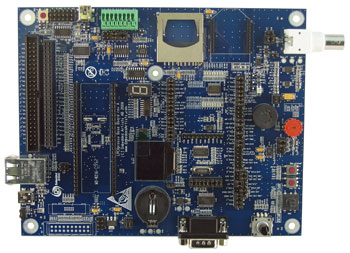 (6
units)
(6
units)
8k RAM, 32k ROM, SSP, I2C, UART, ADC (1114) (2 units)
8k RAM, 32k ROM, UART, I2C, SPI, ADC, PWM, USB (1343) (3 units)
64k RAM, 512k ROM, 4*UART, 3*I2C, SPI, 2*SSP, 2*CAN, PWM, USB 2.0
Device/Host/OTG, RTC, Etehrnet, I2S, ADC (1768) (3 units)
 (1
unit)
(1
unit)
16k RAM, 128k ROM, 2*UART, I2C, SPI, PWM, diodes, buzzer, 2 digital inputs, UART

| Documentation | |
|---|---|
| Leaflet | |
| QuickStart Program Development User's Guide | |
| Schematics | |
| Software | |
| Application for Christmas greetings | sources ">Hex |
Possibility of using uCLinux operating system (see below)

| Documentation | |
|---|---|
| User's guide | |
| QuickStart Program Development User's Guide | |
| MCU
board schematics Base board schematics |
|
| Software | |
| The
board is pre-loaded with 12 sample applications
that demonstrate the different features of the LPC2478 cpu and the LPC2478
QVGA Base Board bundle. The applications are:
|
Sources unavailable hex |
|
examples |
| SDRAM initialization | Sources Hex |
| NicheLite™ (TCP/IP stack) for LPC | Info |
| uCLinux | Info |
(Digi.com, former MaxStream)

| Documentation |
|---|
| Documentation and models |
| QuickStart Program Development User's Guide |
| Windows serial port programming |
| 2148 board guidelines |
| Expresso board guidelines |
| Command sequence and Arduino samples |
33 IO ports, 3.3V, 2*UART, PWM, possibility of connecting ZigBee and remote sets
| Documentation | |
|---|---|
| Documentation | |
| Documentation for Dynamic C | |
| TCP documentation | Intro #1 #2 |
| Software | |
| SDK (requires COM1 and installation in C:/) | |
35 IO ports, 3.3V, interface 802.11b, SPI, UART, 10 different timers, PWM, inceremental encoder, 2*time measurement.
| Documentation | |
|---|---|
| Documentation | |
| Documentation for Dynamic C | |
| TCP documentation | Intro #1 #2 |
| Software | |
| SDK (requires COM1 and installation in C:/) | |
386-like architecture, 64MB RAM, 2MB + Compact Flash, Eth100, pcimcia II; rs485, 2*dac, 2*adc; WiFi, Dev. kit; Dos/Linux + VGA via PC/104
Interfaces Ethernet and RS232, 3.3V, JTAG, complete documentation on the attached CS
Description: http://egnite.de/index.php?id=154&L=2&ftu=7c333a303d
ARM9 architecture, 200MHz, WiFi, Eth 100, 32+MB RAM, 32MB + Flash
| Documentation | |
|---|---|
| Description | |
| Documentation | |
| User's guide | |
| Schematics | |
| Book | |
| Original disk image |